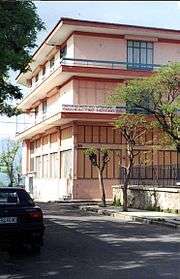Edessa Ecclesiastical Museum
The Edessa Ecclesiastical Museum was founded in the northern Greek city of Edessa in 1996, by the local Diocese of Edessa, Pella, and Almopia. The museum is located on the outskirts of the traditional Varossi district and adjacent to Kokkinos Vrahos. It occupies the second floor of a three-storey building owned by the diocese.

The most important exhibits are ecclesiastical, but there are also mementoes of the Greeks' liberation struggles, of resistance to external foes, and of the fostering of the Christian faith.
Exhibits include altar doors from old churches in the Pella prefecture, post-Byzantine icons of the Panagia, the crucified Christ, and saints, oil lamps and candelabra, chalices, ecclesiastical vessels, icons from chancel screens, epitaphii (most notable among which is the Russian epitaphios from the church of Aridaia, which dates from the time of the tsars), the vestments of the last three metropolitans of Edessa, Pella, and Almopia, rare ecclesiastical books, and numerous photographs of the various activities carried out within the diocese.
There are also portraits and uniforms of men who took part in the Macedonian Struggle in the 1900s, traditional womens' costumes, an Italian weapon that is a trophy of the Greco-Italian War of 1940, and the front page of the Makedonia newspaper describing the victories of the Greek army on the Albanian front during that war.
 The Vestments of the last three Metropolitans
The Vestments of the last three Metropolitans Bema doors
Bema doors Holy crosses and icons
Holy crosses and icons Photos of the activities of the Diocese
Photos of the activities of the Diocese
Sources
- This article incorporates text from the corresponding article at the Museums of Macedonia website, commissioned by the Macedonian Heritage foundation, written by Vlasis Vlasidis, and published under a CC-BY-SA-3.0 license.